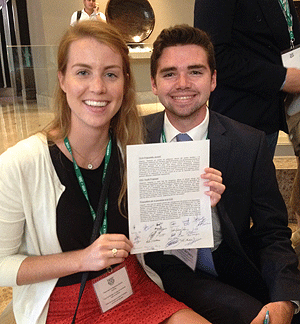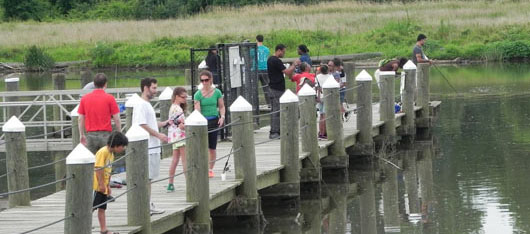Historic Youth Delegation Attends CEC Council Session in Mexico
By Sophie Faaborg-Andersen, Justin McCartney, and Professor James Olsen. Additional work by Aaron Silberman and Sara Carioscia.
In early September, a small delegation from Georgetown University attended the 23rd Summit of the Commission for Environmental Cooperation’s (CEC) Council. The CEC is a trinational organization dedicated to addressing North American environmental concerns. The delegation to the CEC was organized by the Environmental Future(s) Initiative (EFI) and cosponsored by the Georgetown University Offices for the Vice President for Global Engagement and the Provost. Here are their experiences in Mexico in their own words:
Sophie Faaborg-Andersen
Attending the CEC Session was a tremendous experience that made me proud to be a member of the EFI. The Council Session addressed a number of topics, including climate change action, sustainable communities, and youth and the environment. With the Youth Engagement Project Proposal, the EFI sought to create a two-pronged approach for engaging youth in environmental action centered around their input into policymaking and the development of community youth outreach programs.
Attending the Session heightened my appreciation for the importance of integrating marginalized youth voices into policymaking processes. I was delighted to see the ministers of the U.S., Canada, and Mexico refer to their significant indigenous populations and the contributions they can make to the CEC through traditional ecological knowledge (TEK). Additionally, it was an honor to be able to collaborate with our youth counterparts from Mexico and Canada and deliver a presentation to the three Council ministers during the Townhall Session at the conclusion of the conference. The proposal was graciously received, and I am excited by the prospect of our ideas being taken into account in future discussions.
Justin McCartney
My experience at the CEC Council Session was defined by both the conference itself and the prospect for further developing youth engagement going forward. I was delighted when our delegation was given the opportunity to personally meet and speak with U.S. EPA’s Administrator, Gina McCarthy. During our private conversation with her, we discussed our proposal and ideas for how youth engagement can be systematized at the national and international level. I was excited by how clearly Administrator McCarthy understood the importance of integrating youth themselves into the processes for designing youth engagement.
Additionally, I was inspired by our impromptu collaboration with counterparts from Mexico and Canada on a proposal for permanent youth engagement. Huddled around a laptop in the hotel lobby, hashing out our demands: this for me was emblematic of what our time in Mexico was truly about.
Professor James Olsen
It’s hard to overstate how gratifying the experience of leading the delegation to the CEC Council Session was for me as an educator, observing our students’ excitement, dedication, and success as they offered substantive proposals to government officials. While I can’t scale and recreate this trip for each of my students, I’m impressed by the pedagogical principles that can directly inform course design generally, substantively improving our students’ learning and growth.
I am confident that this trip, as well as the principles that governed the trip (including the student-driven nature of the delegation to the development of external partnerships involving real stakes), functioned in a transformative way for these students. I’m just as confident that on a less grand scale, our classrooms can implement similar structural features and foster the positive transformation of our students.
All the authors and co-authors were members of Georgetown University’s delegation to the CEC conference this October in Merida, Mexico.




















 (Winning video submitted by Toxic Soil busters for
(Winning video submitted by Toxic Soil busters for 


